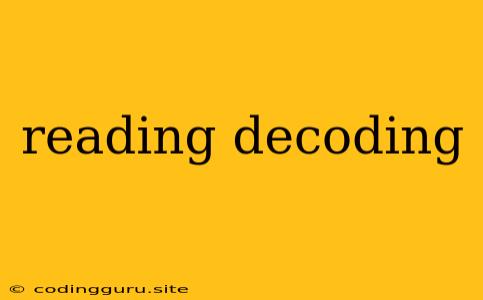Unlocking the Secrets of Reading: A Deep Dive into Decoding
Reading is a fundamental skill that opens doors to countless possibilities. It allows us to access information, engage with literature, and connect with the world around us. However, for many individuals, reading can be a challenging process, filled with roadblocks and frustration. This is where decoding comes in.
What is Decoding?
Decoding is the process of breaking down written language into its smallest units, such as sounds and letters, and then blending them together to form words. It is the foundation of reading fluency, allowing us to recognize words automatically and effortlessly.
Why is Decoding Important?
Imagine trying to read a book without knowing the meaning of the words. That's what it's like for someone who struggles with decoding. Without a solid understanding of how letters correspond to sounds, reading becomes a laborious and frustrating task.
Decoding is crucial for:
- Developing reading fluency: Being able to decode words quickly and accurately allows readers to focus on comprehending the meaning of the text.
- Building vocabulary: Decoding helps us recognize unfamiliar words and expand our vocabulary.
- Improving comprehension: When we can decode words effortlessly, we can focus on understanding the overall message of the text.
Decoding Strategies: Unlocking the Code
Decoding can seem like a complex puzzle, but with the right strategies, it becomes an engaging and rewarding journey. Here are some effective approaches:
1. Phonics:
This strategy focuses on the relationship between sounds and letters. Children are taught how to recognize letter patterns and how to sound them out to read words.
2. Sight Words:
These are frequently encountered words that children learn to recognize automatically, like "the," "and," and "said." Frequent exposure helps children commit these words to memory, making them less reliant on decoding for those specific words.
3. Context Clues:
By using surrounding words and sentences, readers can often infer the meaning of unfamiliar words.
4. Multisensory Learning:
Engaging multiple senses, like sight, sound, and touch, can enhance decoding skills. Activities like using manipulatives, singing songs, and acting out stories can be very effective.
Addressing Decoding Challenges
Not everyone learns to decode at the same pace. Here are some tips for addressing decoding challenges:
- Early Intervention: Identify and address decoding difficulties as early as possible.
- Targeted Instruction: Provide personalized instruction that focuses on the specific areas where a student is struggling.
- Multimodal Approach: Utilize a combination of strategies and techniques to cater to different learning styles.
- Patience and Encouragement: Remember that learning to decode takes time and practice.
Decoding: A Gateway to a World of Possibilities
Mastering decoding is the key to unlocking a world of reading. It empowers individuals to confidently navigate the printed word, engage with literature, and access a vast ocean of knowledge.
Remember, decoding is a process, not a destination. With dedication and the right strategies, anyone can become a proficient and confident reader.
Conclusion
Decoding is the fundamental building block of reading comprehension. By understanding the relationship between sounds and letters, utilizing decoding strategies, and addressing challenges effectively, we can empower individuals to unlock the joy and potential of reading.
